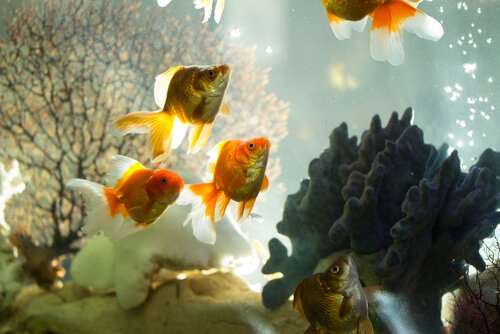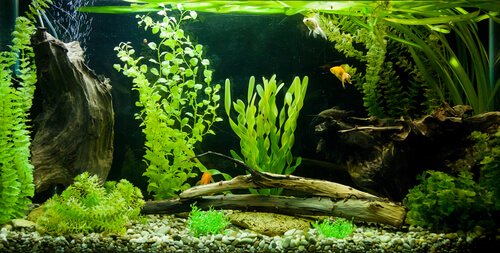Four Good Types of Filters for your Aquarium

An aquarium full of colorful fish is a lovely addition to any home or room. Of course, in order to keep it looking nice and neat, it will require a good filter.
The filter is one of the most fundamental pieces of an aquarium. It’s what keeps the biome balanced and healthy in order for fish to live there. In order to choose the right filter for your aquarium, it will require a lot of research.
The ideal aquarium
It’s easy to spend a lot of time daydreaming about what kind of aquarium you want, and how you might decorate it. Those elements are important, but few people think about how they’re going to choose a filter to keep the aquarium comfy and healthy for the fish.
The pet store offers several kinds of filters that can adjust easily for your fish’s need. Therefore, it’s really important to know how to choose the right one. The most relevant factor is the cleanliness of the environment. So, filter’s must be able to absorb any impurities and gunk floating around in the water.
When we say “impurities” and “gunk,” we mean excrement and any leftover fish food floating in the water. The filter is also in charge of maintaining the good bacterial flora to prevent any illnesses from appearing.

It’s also the filter’s job to make sure the nitrogen cycle is happening correctly. It helps oxygen spread evenly throughout the tank. If this system fails, the fish could all be poisoned by nitrates in the water, which can be lethal.
Differences in filters
Filters come in all shapes and sizes. Some are internal and others are external. In small fish tanks, it’s common to see internal filters. Larger aquariums tend to use external filters.
What’s for sure is that different filters purify a little differently. There are two main types: chemical or mechanical. Both their functions and structures can differ.
- Mechanical filters absorb by sucking water through a porous opening, or a screen that retains waste.
- Chemical filters eliminate toxic elements in the water and make sure that the pH levels are good for fish life.
- Biological filtration takes place when bacteria is created to help the nitrogen cycle and keep the water clean.
Biological filtration occurs naturally during the acclimatization process of the aquarium. Once the tank reaches proper conditions (in three or four weeks) at least two types of beneficial bacteria should be created. They each help with the nitrogen cycle as well.

In the rest of the article, you can find out about what are the good filters for aquariums. Keep in mind that each filter works a little differently, and some adapt better to certain sizes of aquariums.
Types of fish tank filters
Container filters
Designed for large aquariums, these filters have a built-in container that’s meant to store waste. Container filters operate mechanically by sucking the water from the inside of the tank and have it pass through several screens with chemicals and catch any biological waste.
The problem with these filters is that they take up a lot of space due to the container, Likewise, they are typically more expensive. However, they’re much easier to clean than external filters.
Hang-on-back filters (HOB)
This kind of filter hangs on one side of the tank. It sucks up water through a tube inside the container then expels it through a pipe towards the tank. This is best for medium-sized or larger tanks.
These filters have three internal mechanisms that clean the tank from residue and toxins. Most of them are high-quality and inexpensive, but they’re a little more difficult to clean.
Internal filters
As the name indicates, this category of filter does its work from inside the tank. They’re medium or small, designed to work along with another larger filter. Many of them produce bubbles that help regulate oxygen in the aquarium. (And the fish sometimes like to play in them!)
These are the cheapest and smallest options. The problem is that they usually need more maintenance than those the ones previously mentioned.
Foam filters
This kind of internal filter could be combined with another filter, but this one is different in cost, size, and method. These have sponges that trap waste by releasing air bubbles. These are the cheapest filters for small aquariums. However, they can also be fairly large. Plus, the sponge creates a bacterial cap that’s good for the tank. These are ideal for small aquariums that are less effective on larger ones.
An aquarium full of colorful fish is a lovely addition to any home or room. Of course, in order to keep it looking nice and neat, it will require a good filter.
The filter is one of the most fundamental pieces of an aquarium. It’s what keeps the biome balanced and healthy in order for fish to live there. In order to choose the right filter for your aquarium, it will require a lot of research.
The ideal aquarium
It’s easy to spend a lot of time daydreaming about what kind of aquarium you want, and how you might decorate it. Those elements are important, but few people think about how they’re going to choose a filter to keep the aquarium comfy and healthy for the fish.
The pet store offers several kinds of filters that can adjust easily for your fish’s need. Therefore, it’s really important to know how to choose the right one. The most relevant factor is the cleanliness of the environment. So, filter’s must be able to absorb any impurities and gunk floating around in the water.
When we say “impurities” and “gunk,” we mean excrement and any leftover fish food floating in the water. The filter is also in charge of maintaining the good bacterial flora to prevent any illnesses from appearing.

It’s also the filter’s job to make sure the nitrogen cycle is happening correctly. It helps oxygen spread evenly throughout the tank. If this system fails, the fish could all be poisoned by nitrates in the water, which can be lethal.
Differences in filters
Filters come in all shapes and sizes. Some are internal and others are external. In small fish tanks, it’s common to see internal filters. Larger aquariums tend to use external filters.
What’s for sure is that different filters purify a little differently. There are two main types: chemical or mechanical. Both their functions and structures can differ.
- Mechanical filters absorb by sucking water through a porous opening, or a screen that retains waste.
- Chemical filters eliminate toxic elements in the water and make sure that the pH levels are good for fish life.
- Biological filtration takes place when bacteria is created to help the nitrogen cycle and keep the water clean.
Biological filtration occurs naturally during the acclimatization process of the aquarium. Once the tank reaches proper conditions (in three or four weeks) at least two types of beneficial bacteria should be created. They each help with the nitrogen cycle as well.

In the rest of the article, you can find out about what are the good filters for aquariums. Keep in mind that each filter works a little differently, and some adapt better to certain sizes of aquariums.
Types of fish tank filters
Container filters
Designed for large aquariums, these filters have a built-in container that’s meant to store waste. Container filters operate mechanically by sucking the water from the inside of the tank and have it pass through several screens with chemicals and catch any biological waste.
The problem with these filters is that they take up a lot of space due to the container, Likewise, they are typically more expensive. However, they’re much easier to clean than external filters.
Hang-on-back filters (HOB)
This kind of filter hangs on one side of the tank. It sucks up water through a tube inside the container then expels it through a pipe towards the tank. This is best for medium-sized or larger tanks.
These filters have three internal mechanisms that clean the tank from residue and toxins. Most of them are high-quality and inexpensive, but they’re a little more difficult to clean.
Internal filters
As the name indicates, this category of filter does its work from inside the tank. They’re medium or small, designed to work along with another larger filter. Many of them produce bubbles that help regulate oxygen in the aquarium. (And the fish sometimes like to play in them!)
These are the cheapest and smallest options. The problem is that they usually need more maintenance than those the ones previously mentioned.
Foam filters
This kind of internal filter could be combined with another filter, but this one is different in cost, size, and method. These have sponges that trap waste by releasing air bubbles. These are the cheapest filters for small aquariums. However, they can also be fairly large. Plus, the sponge creates a bacterial cap that’s good for the tank. These are ideal for small aquariums that are less effective on larger ones.
This text is provided for informational purposes only and does not replace consultation with a professional. If in doubt, consult your specialist.







